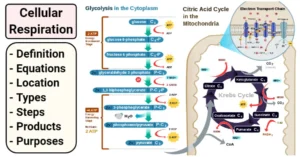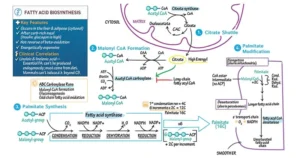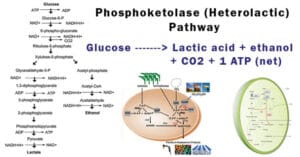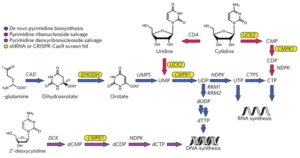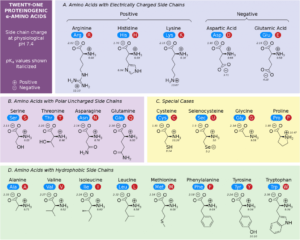Introduction – TCA Cycle (Tricarboxylic Acid) or Krebs cycle
The Tricarboxylic Acid (TCA) cycle, also known as the Krebs cycle or citric acid cycle, is a central metabolic pathway that plays a crucial role in cellular respiration. This cycle, occurring in the mitochondria of eukaryotic cells, is essential for the generation of energy and the production of important precursors for biosynthesis. In this article, we will explore the TCA cycle in detail, accompanied by a flow chart to illustrate the key biochemical processes involved.
The TCA cycle is a series of chemical reactions that completes the oxidative breakdown of carbohydrates, fatty acids, and amino acids. It is named after citric acid, the first compound formed in the cycle. The TCA cycle connects glycolysis, which occurs in the cytoplasm, to the electron transport chain, facilitating the production of adenosine triphosphate (ATP), the cell’s primary energy currency.
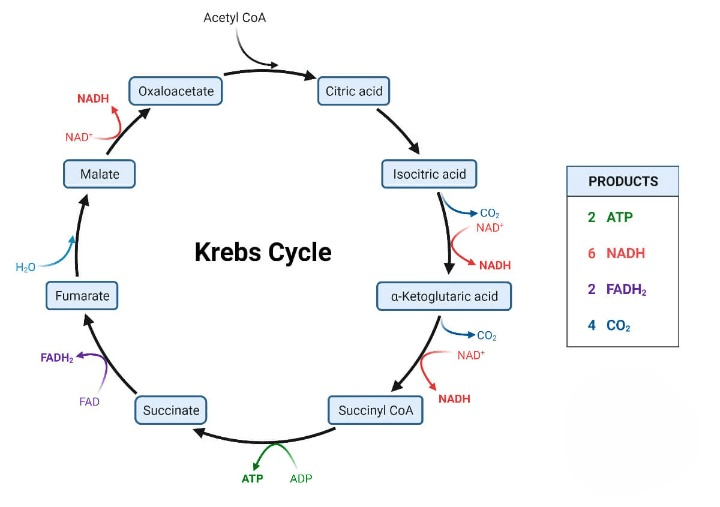
- This metabolic pathway is known as the citric acid cycle because the initial metabolic compound generated within the cycle is citric acid.
- Initially, the cycle was also referred to as tricarboxylic acid (TCA) due to uncertainty about whether citric acid or another tricarboxylic acid, such as isocitric acid, was the primary output of the cycle. However, subsequent research has confirmed that citric acid is indeed the initial product. Consequently, the use of the term tricarboxylic acid for this cycle has been discouraged.
- The occurrence of this cycle is exclusive to aerobic conditions since energy-rich molecules like NAD+ and FAD can only be regenerated from their reduced forms after transferring electrons to molecular oxygen.
- The citric acid cycle serves as the ultimate converging route for the oxidation of various biomolecules, including proteins, fatty acids, and carbohydrates. Molecules originating from different cycles and pathways gain entry into this cycle by being transformed into Acetyl CoA.
- The citric acid cycle constitutes a recurring series of eight enzyme-mediated reactions. Its significance lies in its role as a vital contributor to the electron transport chain, offering electrons and high-energy molecules. This contribution is crucial for the synthesis of ATPs and water, making the cycle a pivotal component in cellular energy production.
- Following glycolysis, pyruvate undergoes oxidation to form Acetyl CoA before it can enter the citric acid cycle. This conversion of pyruvate to Acetyl CoA serves as a crucial preparatory step, ensuring the proper integration of carbon metabolism between glycolysis and the citric acid cycle.
TCA Cycle Location
- In eukaryotes, the citric acid cycle occurs within the mitochondria, whereas in prokaryotes, it takes place in the cytoplasm.
- The pyruvate generated in the cytoplasm through glycolysis is transported into the mitochondria for subsequent reactions.
- Within the mitochondria, various enzymes responsible for the citric acid cycle are strategically located, with some situated in the inner membrane and others in the matrix space.
- This compartmentalization ensures the organized and efficient progression of the cycle in its designated cellular environment.
TCA Cycle Equation/ Reaction
The comprehensive equation for the citric acid cycle is expressed as follows:
Acetyl CoA, along with three molecules of NAD+, one molecule of FAD, one molecule of ADP, and one molecule of inorganic phosphate (Pi), undergoes a series of enzymatic reactions leading to the production of two molecules of carbon dioxide, three molecules of NADH, three hydrogen ions (H+), one molecule of FADH2, and one molecule of ATP.
In words, the equation can be articulated as:
Acetyl CoA, Nicotinamide adenine dinucleotide (NAD+), Flavin adenine dinucleotide (FAD), Adenosine diphosphate (ADP), and Phosphate (Pi) undergo transformations resulting in the generation of Pyruvate, Water, Adenosine triphosphate (ATP), Nicotinamide adenine dinucleotide (NAD+), and Hydrogen ions.
The TCA cycle enzymes
In eukaryotic cells, the enzymes responsible for catalyzing the reactions of the citric acid cycle predominantly reside in the matrix of the mitochondria. However, two exceptions to this localization pattern are succinate dehydrogenase and aconitase, which are found in the inner mitochondrial membrane.
A noteworthy commonality among the enzymes participating in the citric acid cycle is their dependence on the presence of Mg2+, with nearly all of them requiring this essential cofactor for their proper functioning.
The series of reactions constituting the citric acid cycle are facilitated by the following enzymes:
- Citrate Synthase: Initiates the cycle by combining Acetyl CoA with oxaloacetate to form citrate.
- Aconitase: Catalyzes the isomerization of citrate to isocitrate.
- Isocitrate Dehydrogenase: Facilitates the oxidation of isocitrate, leading to the release of carbon dioxide and the formation of alpha-ketoglutarate.
- α-Ketoglutarate Dehydrogenase: Promotes the decarboxylation of alpha-ketoglutarate, resulting in the production of succinyl-CoA.
- Succinyl-CoA Synthetase: Converts succinyl-CoA to succinate, generating a high-energy phosphate bond in the process.
- Succinate Dehydrogenase: Catalyzes the oxidation of succinate, transferring electrons to the electron transport chain, and is unique as it is embedded in the inner mitochondrial membrane.
- Fumarase: Mediates the hydration of fumarate to form malate.
- Malate Dehydrogenase: Concludes the cycle by oxidizing malate to regenerate oxaloacetate.
This orchestrated interplay of enzymes within the mitochondria underscores the intricacies of the citric acid cycle, a pivotal pathway in cellular respiration.
Key Steps of the TCA Cycle:
Acetyl-CoA Entry: The TCA cycle kicks off with the entrance of acetyl-coenzyme A (Acetyl-CoA) into the cellular stage. In a choreographed reaction orchestrated by citrate synthase, Acetyl-CoA combines with oxaloacetate, giving rise to citrate—the first player in this metabolic performance.
Isocitrate Formation: Next in line is the transformation of citrate into isocitrate. Aconitase takes the lead in this phase, facilitating the isomerization process and preparing the substrate for the subsequent steps in the cycle.
Alpha-Ketoglutarate Production: As the cycle progresses, isocitrate undergoes oxidation, resulting in the liberation of carbon dioxide and the emergence of alpha-ketoglutarate. Isocitrate dehydrogenase orchestrates this transformation, setting the stage for the cascade of reactions to follow.
Succinyl-CoA Formation: Alpha-ketoglutarate takes center stage in the next act, experiencing decarboxylation to produce succinyl-CoA and carbon dioxide. The catalytic prowess of alpha-ketoglutarate dehydrogenase propels this pivotal step forward in the TCA cycle.
Succinate Generation: A seamless transition leads us to the conversion of succinyl-CoA to succinate. Succinyl-CoA synthetase is the choreographer in this step, overseeing the release of CoA and the formation of a high-energy phosphate bond, contributing to the cell’s energy currency.
Fumarate Formation: Succinate undergoes a transformative process orchestrated by succinate dehydrogenase, culminating in its oxidation to fumarate. This step simultaneously transfers electrons to the electron transport chain, further connecting the TCA cycle to the larger web of cellular energy production.
Malate Production: Fumarate yields the stage to fumarase, which catalyzes the hydration of fumarate to form malate. This step marks a critical transition as the cycle approaches its completion, with malate poised to play a vital role in the final act.
Oxaloacetate Regeneration: The grand finale of the TCA cycle unfolds with malate’s oxidation to oxaloacetate, guided by the expertise of malate dehydrogenase. This step brings the cycle full circle, ensuring the continuous regeneration of oxaloacetate to fuel subsequent rounds of the TCA dance.
Role of the TCA Cycle in Cellular Respiration:
The TCA cycle is central to cellular respiration, contributing to the generation of reducing equivalents (NADH and FADH2) that feed into the electron transport chain. This, in turn, leads to the production of ATP through oxidative phosphorylation, providing the cell with the energy required for various biological processes.
The Tricarboxylic Acid (TCA) cycle stands as a cornerstone of cellular metabolism, orchestrating the breakdown of diverse fuel sources and serving as a nexus for energy production. The flow chart presented here provides a visual representation of the key biochemical processes in the TCA cycle, emphasizing the cyclical nature of this fundamental pathway. Understanding the intricacies of the TCA cycle unveils the remarkable sophistication of cellular energy metabolism and its pivotal role in sustaining life.

